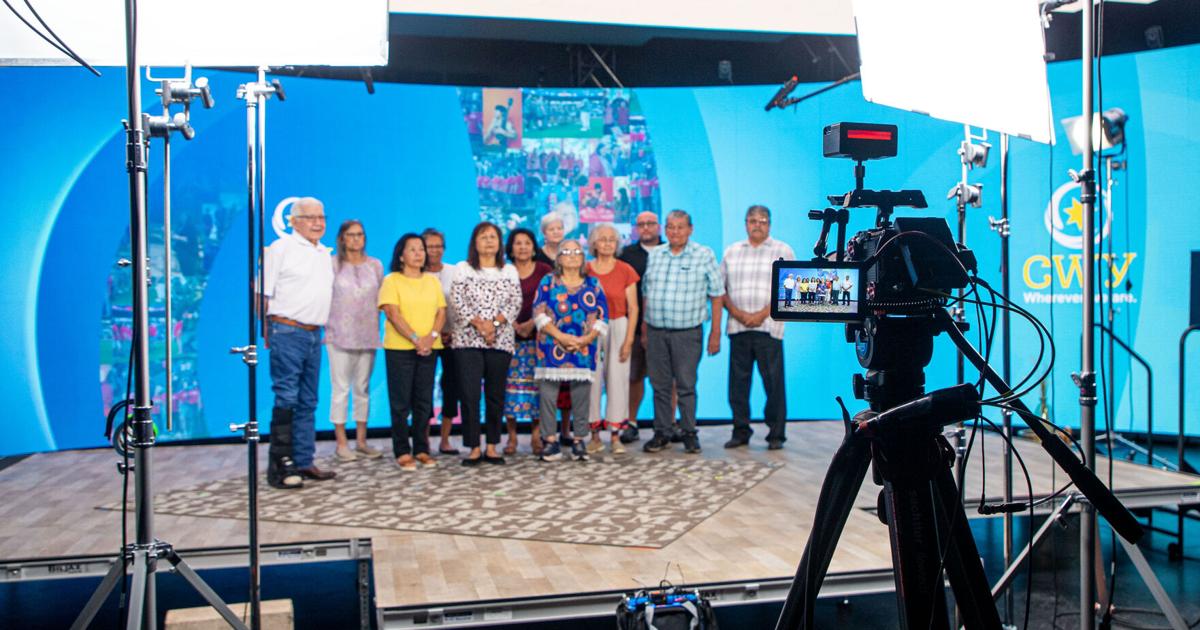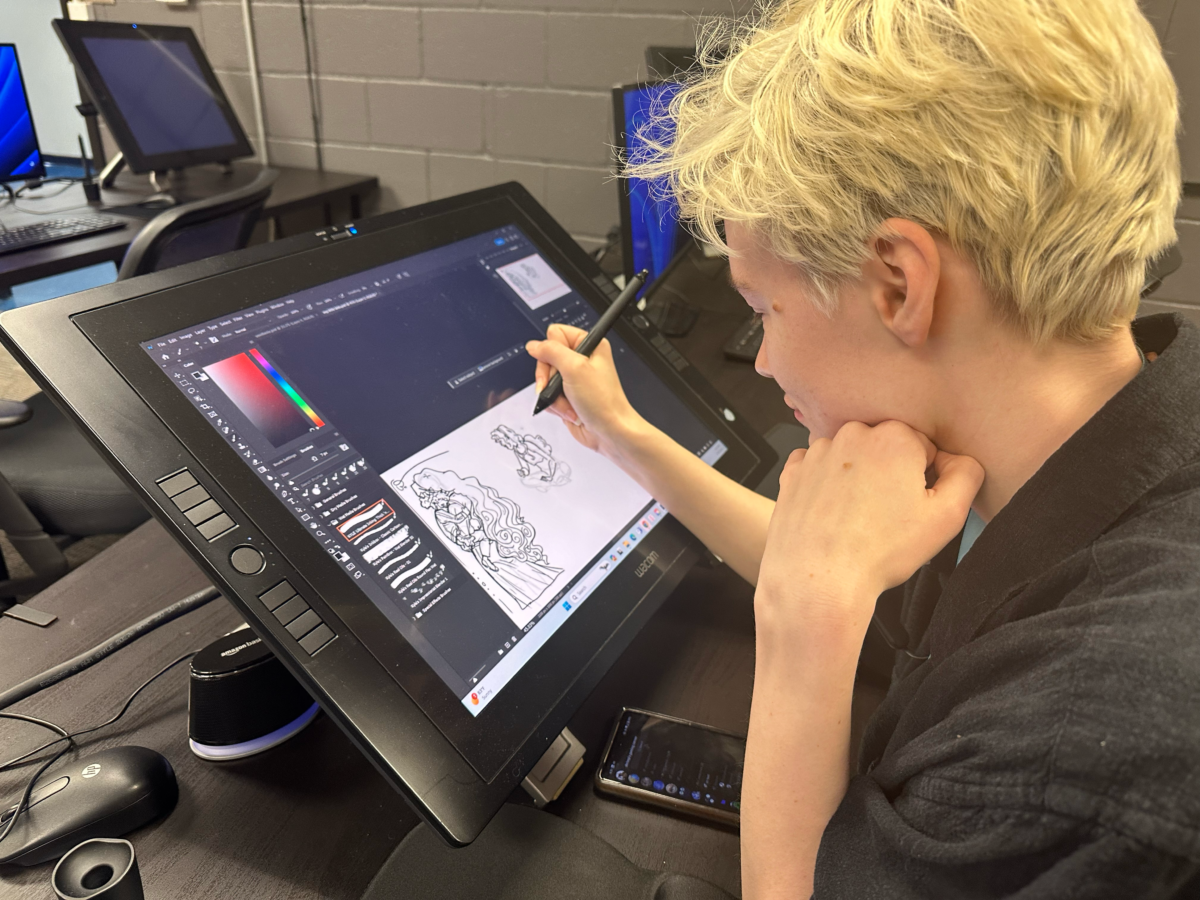“Take two deep breaths, and then we’ll begin,” Austin Parker says to the leader of the Cherokee Baptist Choir.
Parker, a video production manager, adjusts the cameras as pastor DJ McCarter introduces the audience to what he and the Cherokee Baptist Choir will be performing. Once the choir begins singing “Dedication to the Children,” cameras pan out to feature the entire chorale.
Bright lights surround them as they sing in Cherokee. The studio is silent other than their voices, making sure few takes are needed for the July episode of the tribe’s “ᏣᎳᎩ: Wherever We Are” monthly series.
As the choir finishes, Parker holds up his hand, guaranteeing the studio stays silent until he loudly announces “And cut!”
Onlookers in the studio burst into applause, and workers quickly move to change the set for the next segment of the show.
People are also reading…
The monthly series is produced at Cherokee Film Studios in Owasso, one of four studios with soundstages in Oklahoma.
As Oklahoma’s film industry grows, there are more opportunities for infrastructure to be built, and the Cherokee Nation is leading the way in this part of the state.
Last week, Cherokee Nation announced an expansion and reorganization of its filmmaking hub. Cherokee Film’s portfolio includes four branches — Cherokee Film Productions, Cherokee Film Studios, Cherokee Film Commission and Cherokee Film Institute — and represents more than 30 full-time employees.
And on Wednesday, the tribe celebrated the groundbreaking of its second soundstage at Cherokee Film Studios in Owasso.
“It’s an opportunity to be part of what is a forever industry,” Cherokee Nation Principal Chief Chuck Hoskin Jr. said. “I mean film, TV, and creative content — it’s going to be with us forever. The avenues for producing it and avenues for consuming it by viewers and listeners are growing and growing.”
The goal is to get more Native American representation in all levels of the film industry.
“It gives us an opportunity to tell our story,” Hoskin said. “Because we have the technology, we have the resources to do that today in a way we haven’t for a long, long time. For generations, other people have told our story. They’ve sometimes told it right; more often they told it wrong or incomplete.”
Supporting representation
The first soundstage opened in 2021 to help support the emerging film industry.
Senior director of Cherokee Film Jennifer Loren hosts multiple television shows for the Cherokee Nation, including “ᏣᎳᎩ: Wherever We Are,” which was created to connect Cherokee people with their culture regardless of their location.
“The more that we can educate people about what it really means to be Cherokee the better, because there’s lots of misconceptions about who Cherokee people are,” said Loren. “A lot of times Native Americans just get lumped into one group when we all have very specific cultures.”
According to the 2021 Hollywood Diversity Report conducted by the University of California Los Angeles, Native Americans only had 0.6 percent of all film roles in 2020. There were no Native American directors or writers that year, according to the study.
Loren said representation for Native Americans and Cherokee people has always been important to her. This mission inspired the founding of the Cherokee Nation Film Office in 2019 and the opening of the Cherokee Film Studios in Owasso three years later.
The 27,000-square-foot facility opened in 2021 and its 14,000-square-foot stage has been home to more than 30 productions. Along with a soundstage, the facility is home to editing suites, hair and makeup facilities, lounges and control rooms. This studio is not exclusively for tribal citizens, but Native American representation is encouraged and incentivized.
In 2022, the Cherokee Nation created a film incentive to support productions made within the 14 counties of the Cherokee Nation. Applicants are incentivized to hire citizens of any federally recognized tribe by receiving increased rebates for having them in both above and below the line roles.
In film industry terms, above the line roles include directors, writers, producers and principal cast. Below the line roles are all of the various roles required for filmmaking. This ranges from supporting cast, electricians and lighting directors, to caterers and other support services needed.
The CNFO website also includes a native talent directory, so productions interested in filming within the Cherokee Nation have a database for hireable cast and crew.
The rebate has a $1 million annual cap but is stackable with the Oklahoma Film Incentive. It requires a minimum spend of $50,000 in Oklahoma, and $25,000 of that must be within the Cherokee Nation.
Unique technology
The first movie filmed at Cherokee Film Studios was “Land of Gold.” Directed by Nardeep Khurmi, the film follows the story of a Punjabi-American trucker’s last route before he becomes a father. During this route he finds a 10-year-old stowaway in need of safe passage. The drama explores the experiences of first-generation Americans and themes of race, identity and found family.
CNFO was also a cultural consultant for the film, as they added a Native American character to the movie.
It was the first film that used Cherokee Film Studios Extended Reality (xR) technology. The studio is equipped with a 77-foot-long curved LED screen and 52-foot ceiling panels, which help create dimensional scenes.
The xR technology was first used in the popular Disney+ Series “The Mandalorian,” and this same technology was used in “Land of Gold” to provide more immersive road trip scenes.
Micheal Lister is the virtual productions manager for CNFO and oversees the use of xR technology at the soundstage. He said “Land of Gold” was by far one of the most fun productions he’s worked on, as he helped filmmakers re-create a 3,000-mile road trip from California to Maine.
“What really sets us apart, I think, from other soundstages in the region, or even other xR studios, is (we’re) incredibly modular and agile,” Lister said. “So, we can be set up to handle a lot of different types of productions.”
These types of productions include external feature films, fully virtual motion capture productions, animated productions and internal productions such as “Voices of the People” and “Wherever We Are.”
Lister said he hopes to use his experience to encourage Native Americans to join the film industry.
“I think for a lot of us, especially guys like me, who grew up in a small town in rural Oklahoma, film and animation production and stuff like that, almost seemed like a mythical thing — like some far-off thing that lived in Hollywood,” said Lister. “To have this type of technology here to be able to stay in the areas and the regions that you care about and contribute to that so directly makes it so special.”
Tava Maloy Sofsky became director of the Cherokee Film Commission in 2022 after leaving her position as director of the Oklahoma Film + Music Office. Before moving to Oklahoma to begin that job, she worked in the film industry in Los Angeles for 15 years.
She said she believes everyone can have a place in the film industry and wants to ensure Cherokee people don’t have to leave the Nation to achieve their dreams.
“People think it’s all glitz and glamor,” Sofsky said about working in film. “It’s a lot of hard work, but it’s really rewarding, as well.”
Sofsky said she thinks behind the scenes is where all the magic happens and hopes to educate Cherokee people about all the different jobs available to them within the industry.
The Cherokee Nation partnered with Oklahoma State University-Tulsa in 2021 to create educational opportunities for Native Americans who are interested in joining the film industry. There are public, non-credit workshops available, which CNFO has helped provide 100 scholarships for. Workshops lessons have ranged from special effects makeup training, how to get cast as an extra in film productions, and even on-set film etiquette.
“That means that a Cherokee who wants to be in production, wants to be a writer, wants to be on a crew, in front of the camera, or behind the camera can get skills here in the region,” Hoskin said. “Then, if we do our jobs right, they can stay here in the region and work.”
Users can customize the app so you see the stories most important to you. You can also sign up for personalized notifications so you don’t miss any important news.
If you’re on your phone, download it here now: Apple Store or Google Play






